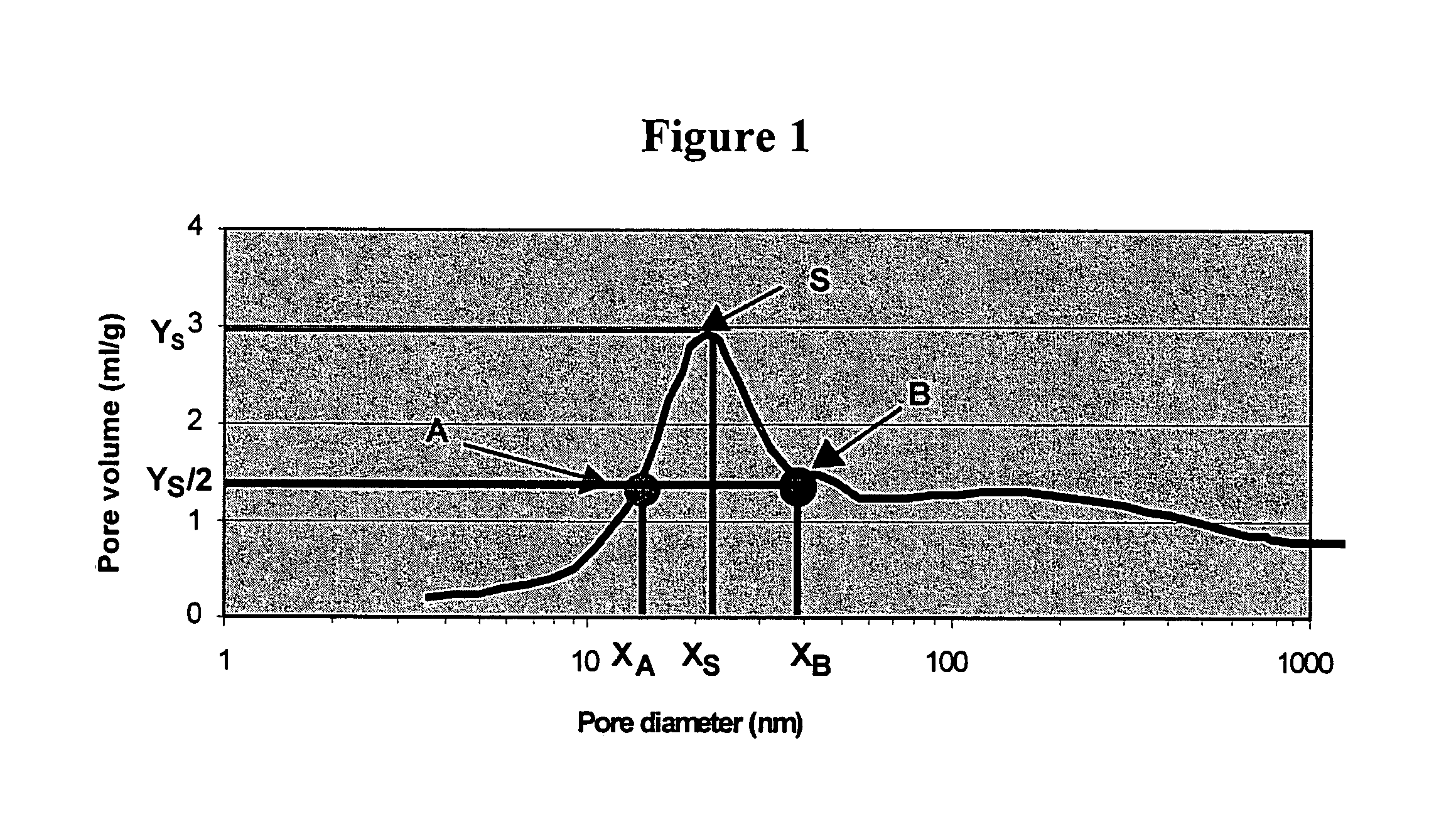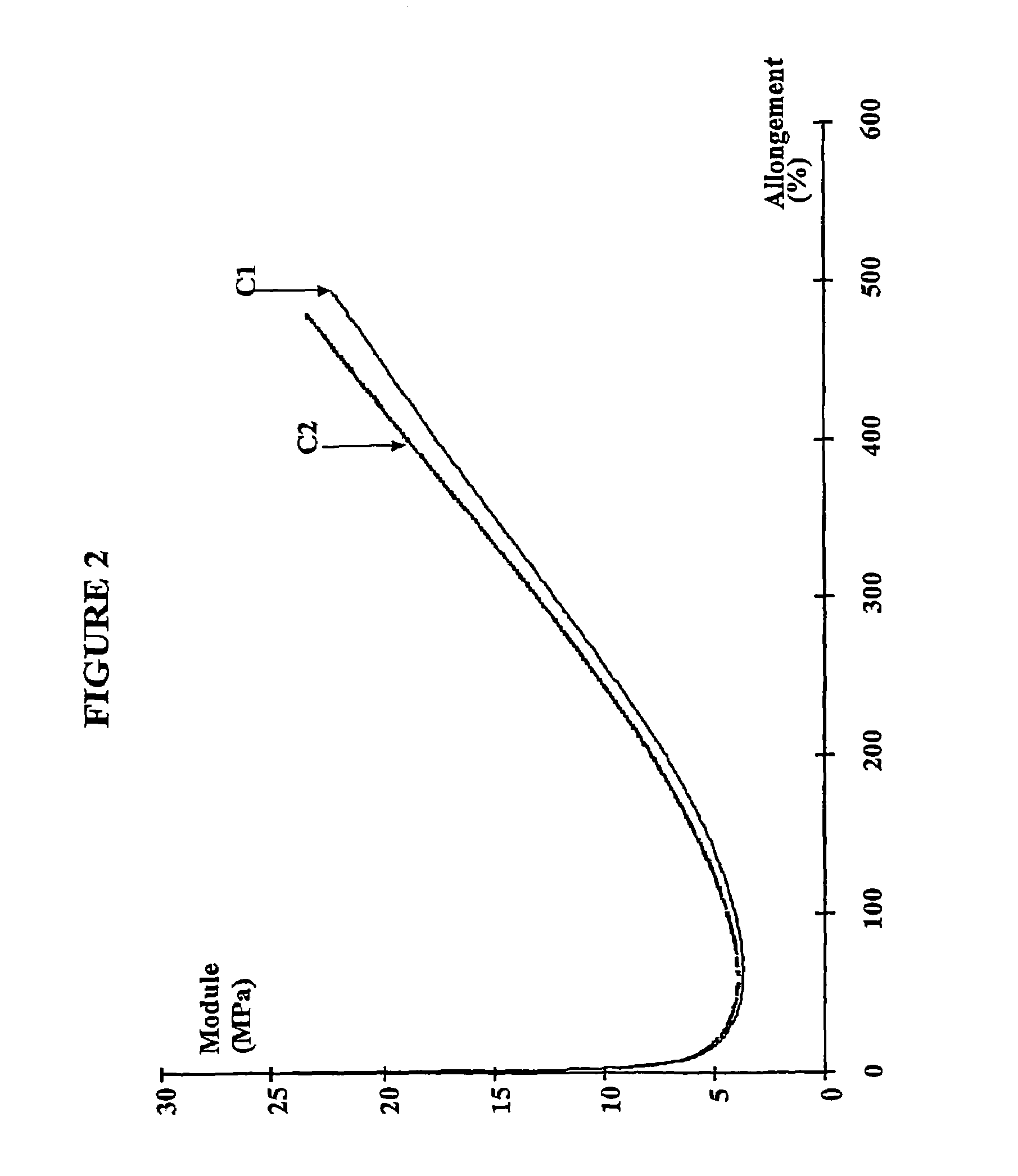Diene rubber composition for tire comprising a specific silica as reinforcing filler
a technology of inorganic filler and diene rubber, which is applied in the direction of silica compounds, transportation and packaging, chemistry apparatus and processes, etc., can solve the problems of limited dispersion of filler, poor dispersion of filler in elastomeric matrix, and more difficult work, so as to achieve high grip, low rolling resistance, and high wear resistance
- Summary
- Abstract
- Description
- Claims
- Application Information
AI Technical Summary
Benefits of technology
Problems solved by technology
Method used
Image
Examples
example 1
III.1.1 Example 1
[0301]10 liters of purified water is introduced into a 25-liter stainless steel reactor. The solution is brought to 80° C. The entire reaction is carried out at this temperature. With stirring (350 rpm, propeller-type stirring), 80 g / l sulfuric acid is introduced until the pH reaches a value of 4.
[0302]There are introduced simultaneously into the reactor over 35 minutes a solution of sodium silicate (of weight ratio SiO2 / Na2O equal to 3.52) having a concentration of 230 g / l and at a flow rate of 76 g / min and sulfuric acid of a concentration equal to 80 g / l at a flow rate regulated so as to keep the pH of the reaction medium at a value of 4. At the 30th minute of the addition, the stirring rate is brought to 450 rpm.
[0303]At the end of the 35 minutes' simultaneous addition, the introduction of acid is stopped as long as the pH has not reached a value equal to 9. The flow of silicate is then also stopped. A maturation of 15 minutes at pH 9 is effected. At the end of t...
example 2
III.1.2 Example 2
[0323]700 liters of industrial water is introduced into a 2000-liter reactor. This solution is brought to 80° C. by heating by direct steam injection. With stirring (95 rpm), sulfuric acid, of a concentration equal to 80 g / l, is introduced until the pH reaches a value of 4.
[0324]There are introduced simultaneously into the reactor over 35 minutes a solution of sodium silicate (of weight ratio SiO2 / Na2O equal to 3.52) having a concentration of 230 g / l at a flow rate of 190 l / hour and sulfuric acid, of a concentration of 80 g / l, at a flow rate regulated so as to keep the pH of the reaction medium at a value of 4.
[0325]At the end of the 35 minutes' simultaneous addition, the introduction of acid is stopped as long as the pH has not reached a value equal to 8. Another simultaneous addition is then effected for 40 minutes with a flow rate of sodium silicate of 190 l / hour (same sodium silicate as for the first simultaneous addition) and a flow rate of sulfuric acid of a c...
example 3
III.1.3 Example 3
[0346]10 liters of a solution of sodium silicate (of a weight ratio SiO2 / Na2O equal to 3.53) having a concentration of 5 g / l is introduced into a 25-liter stainless steel reactor. The solution is brought to 80° C. With stirring (300 rpm, propeller-type stirring), sulfuric acid, of a concentration equal to 80 g / l, is introduced until the pH reaches a value of 4.2.
[0347]There are introduced simultaneously into the reactor over 35 minutes a solution of sodium silicate (of weight ratio SiO2 / Na2O equal to 3.53) having a concentration of 230 g / l, at a flow rate of 50 g / min and sulfuric acid, of a concentration equal to 80 g / l, at a flow rate regulated so as to keep the pH of the reaction medium at a value of 4.2.
[0348]At the end of the 35 minutes' simultaneous addition, the introduction of acid is stopped as long as the pH has not reached a value equal to 9. The flow of silicate is then also stopped. A maturation of 15 minutes at pH 9 is effected, while gradually increasi...
PUM
| Property | Measurement | Unit |
|---|---|---|
| specific surface area | aaaaa | aaaaa |
| specific surface area | aaaaa | aaaaa |
| particle size | aaaaa | aaaaa |
Abstract
Description
Claims
Application Information
 Login to View More
Login to View More - R&D
- Intellectual Property
- Life Sciences
- Materials
- Tech Scout
- Unparalleled Data Quality
- Higher Quality Content
- 60% Fewer Hallucinations
Browse by: Latest US Patents, China's latest patents, Technical Efficacy Thesaurus, Application Domain, Technology Topic, Popular Technical Reports.
© 2025 PatSnap. All rights reserved.Legal|Privacy policy|Modern Slavery Act Transparency Statement|Sitemap|About US| Contact US: help@patsnap.com



